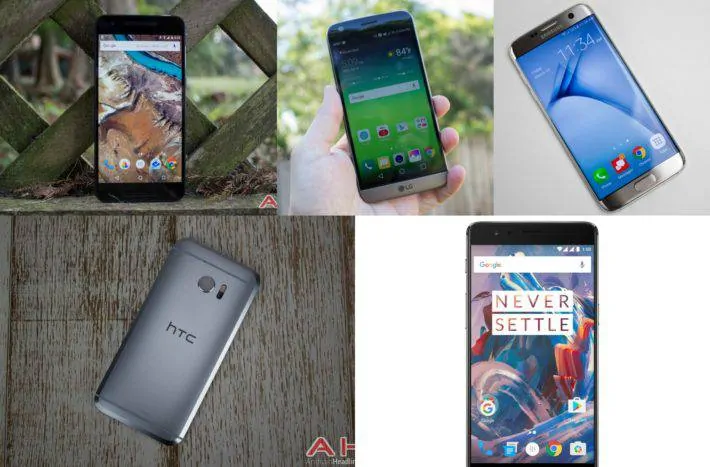Introduction
Do we have a good one for you today – We will be looking at five devices – the Nexus 6P, LG G5, Galaxy S7 Edge, HTC 10, and the new OnePlus 3 announced today! We will look how each of these devices stack up to one another – although we will pay extra attention to the new OnePlus 3. Will the new OnePlus 3 finally earn the title of “Flagship Killer” that was bestowed on the OnePlus 2? The OnePlus 2 never quite lived up to those accolades. This will be an interesting comparison – the other four models have been around for a while, so we know a lot about them. But the new OnePlus 3 is the new kid on the block and we are anxious to compare specs with the more expensive flagships.
OnePlus is a small company that has a band of loyal followers, even though their smartphones have never held any flagship distinction – oh, they offer a great build quality at a terrific price, but in selling them so cheaply, corners have to be cut. It is the simple law of economics – well, maybe not exactly, but you know what I mean. OnePlus may always use a Full HD display and may never offer expanded memory, but that is okay if they want to keep the price down and sell to a limited number of consumers. However, there is no doubt in my mind if OnePlus slapped in a QHD, memory expansion, added more LTE bands for the US, and slapped a $479 price on the device it would sell like hotcakes. But, until OnePlus does that, the OnePlus 3 is the closest thing they have designed to a mainstream flagship smartphone. How does it compete with the other high-end models being offered today? Let’s take a look at the OnePlus 3 and see just how it stacks up to the other devices – the Nexus 6P, LG G5, the Samsung Galaxy S7 Edge, and the HTC 10.
Specifications
Design
The new OnePlus 3 comes with a new all aluminum body with subtle bezels – in other words, it looks like some other phones on the market – Huawei, Honor, Meizu, as well as an iPhone. As with prior OnePlus devices, it has a solid build quality and premium look and feel. The Huawei Nexus 6P is another all-metal designed smartphone with a solid build and premium look – falling right in line with the OnePlus 3, although the Nexus 6P does have a quite a camera bulge on its the upper back. The LG G5 also took the all-metal route, but LG gave it a coating to hide the antenna lines that takes away from its metal feel. The LG G5 took a bold step with a modular design – the bottom edge of the phone can be removed so that the user can slide in a new battery or modules to enhance the user experience. The Samsung Galaxy S7 Edge is a refinement of last year’s new solid metal frame and glass front and back. It was a well-received design (except for the fingerprints) that adds a premium look from any angle – especially with its dual curved display. The HTC 10 is the most complete smartphone that HTC has sent to market – it retains its all- metal design, but it is a new and bold, chamfered look. HTC then added all of the right ingredients to make this a great flagship device.
Display
The OnePlus 3 display is both a stunner and a bummer. It is a stunner in that it is a nice 5.5-inch Optic AMOLED display with great color contrasts and super-thin bezels. It is a bummer because it is the only display in the group that is still using a Full HD resolution. This means 1920 x 1080 pixels and 401 pixels-per-inch (PPI.) For its pricing, a 1080p display is understandable, but why not throw in a QHD display and up the price $30, to fully compete with the other devices. The Nexus 6P comes with a 5.7-inch QHD AMOLED display with 518 PPI. The LG G5 comes with a 5.3-inch IPS LCD QHD ‘always-on’ display with 554 PPI. The Galaxy S7 Edge comes with a 5.5-inch QHD Super AMLOED display with 534 PPI, dual curved edges, and ‘always-on’ display. The HTC 10 comes with a 5.2-inch Super LCD5 OHA display with 565 PPI.
Processor/Memory
OnePlus chose the process of choice for a flagship phone sold in the US – the 64-bit Qualcomm Snapdragon 820 quad-core with two cores clocked at 1.6GHz and two cores clocked at 2.15GHz along with the Adreno 530 GPU for outstanding graphics. It is also packing not 4GB, but 6GB of DDR4 RAM and 64GB of the much faster UFS 2.0 internal memory. The only downside is there is no way to expand that memory for storing 4K videos, high-resolution photos, or the hundreds or thousands of songs you may want to keep. The popular Snapdragon 820 is used in all of the other comparison phones, but the Nexus 6P. It uses the Snapdragon 810, the predecessor to the 820 – it is an octa-core processor clocked at 1.55GHz and 2.0GHz and comes with 3GB of DDR4 RAM and a choice of 32GB, 64GB, or 128GB of storage with no means to expand. The LG G5’s Snapdragon 820 comes with 4GB of DDR4 RAM and 32GB of internal storage that is expandable to 2TB via a microSD card. The Galaxy S7 Edge comes with a Snapdragon 820 in the US and an Exynos 8890 in other countries – however, they all come with 4GB of DDR4 RAM and either 32GB or 64GB of the faster UFS 2.0 memory that is also expandable. The HTC 10 comes with 4GB of DDR4 RAM and either 32GB or 64GB of memory that is also expandable.
Camera Area
Years ago, nobody took cellphone cameras very seriously – now they are one of the top things we look for on a smartphone. It seems that OnePlus took this seriously enough in the OnePlus 3 and put in some impressive specifications. They are using a Sony IMX298 16MP sensor with a quick Phase Detection Autofocus (PDAF), LED Flash, OIS and even EIS (Electronic Image Stabilization), with an aperture of f/2.0 to get some great photos. OnePlus even added a Sony IMX179 8MP sensor for the front-facing camera (FFC), with a large 1.4 µm pixel size, f/2.0, and EIS for selfies and video chatting.
The Nexus 6P uses a 12.3MP sensor with a f/2.0 aperture, laser autofocus, large 1.55 µm pixels, dual-tone LED flash, with no OIS. The FFC has a large 8MP sensor with a f/2.4 aperture for selfies and video chatting.
The LG G5 redid their camera area with a 16MP primary camera with an aperture of f/1.8 and an 8MP wide-angle duo camera with an aperture of f/2.4. It comes with laser autofocus, 3-axis OIS and an LED flash. The FFC is 8MP with an f/2.0 aperture for selfies and video chatting.
The Galaxy S7 Edge uses a new Dual-Pixel 12MP with a large f/1.7 aperture, quick phase detection autofocus (PDAF), OIS, auto HDR and LED flash as its main shooter and a 5MP, f/1.7, 22mm wide-angle and auto HDR for its FFC.
The HTC 10 finally got its camera are in check after years of experimenting – a 12MP HTC UltraPixel 2 sensor with laser autofocus, dual-tone LED flash, a f/1.8 aperture, and OIS. A 5MP FFC with an f/1.8, 23mm, autofocus, HDR, and OIS should allow for some great selfies and video chatting.
Battery
The OnePlus 3 will have a 3000mAh non-removable battery with Dash Charge – able to give you up to 60-percent of battery life in 30 minutes – with a USB V2.0 Type-C reversible cable for charging and data transfer. The Nexus 6P has a larger 3450mAh battery with fast charging capabilities and uses a v2.0 Type-C reversible connector. The LG G5 has a smaller 2800mAh removable battery – the only one of the group – with Quick Charge 3.0 and v3.0 Type-C reversible connector. The Galaxy S7 Edge comes with a large 3600mAh non-removable battery that offers rapid charge and quick wireless charging as well and the older microUSB v2.0 connector. The HTC 10 comes with a 3000mAh non-removable battery with Quick Charge 3.0 and v3.1 Type-C reversible connector.
Features/Observations
The OnePlus 3 measures in at 152.7 x 74.7 x 7.35mm, weighs in at 158 grams, and will cost you $399 USD. It runs OxygenOS on top of Android 6.0.1 for a unique user experience. It has an industry-leading 6GB of DDR4 RAM and the faster UFS 2.0 memory, like the Galaxy S7 Edge. It has a bottom mounted speaker.
The Nexus 6P measures in at 159.3 x 77.8 x 7.3mm, weighs in at 178 grams, and will cost you $499 (32GB), $549 (64GB), or $649 (128GB), although there is a $50 promo going on now for Father’s Day. Being a Nexus device, it will run pure vanilla Android and it will receive the fastest updates possible – direct from Google.
The LG G5 measures 149.4 x 73.9 x 7.7mm and weighs in at 159 grams. Its LCD features the always-on display that saves on battery life and allows the user to glance quickly at the time, date and notifications. The LG G5’s uniqueness is its ability to use modules that add versatility to the device – extra battery life, a physical camera grip and controls, a B&O sound module, with more promised to come. This is a great idea, but outside manufacturers must design and build modules – so you have to ask yourself how expensive will they be and can you use them on the next LG G6, for instance. It could end up being a marketing nightmare for LG.
The Galaxy S7 Edge measures in at 150.9 x 72.6 x 7.7mm, weighs in at 157 grams, and will cost you about $790. The Galaxy S7 Edge is the only device with IP68 dust and water resistance. Its dual curved display features the always-on mode that saves battery life and allows you to grab a quick look at the time, date or notifications. The Galaxy S7 Edge also has a heart rate monitor, oxygen saturation sensor, IP68 certified for dust and water resistance, built-in quick wireless charging and offers Samsung Pay.
The HTC 10 measures 145.9 x 71.9 x 9.0mm and weighs in at 161 grams. It features a new BoomSound Hi-Fi sound with one ‘woofer’ speaker at the bottom of the device and a ‘midrange/tweeter at the top front of the device. It now sports a physical home button that doubles as the fingerprint sensor. The HTC 10 is priced at about $650 and available at Sprint, Verizon, and T-Mobile stores.
All of the devices here are running Android 6.0.1 Marshmallow and all, except the Nexus 6P, are running an overlay of their own User Interface (UI.) The OnePlus 3 will use their latest OxygenOS, LG G5 uses LG’s Optimus UX 5.0 UI, the Samsung Galaxy S7 Edge runs TouchWiz UI, and the HTC 10 will run their Sense UI. All devices, including the OnePlus 3, are available for sale as of today. All models, except the S7 Edge, are using the new Type-C reversible port for battery charging and data transfer, whereas the Samsung models use the older style v2.0 microUSB. All five devices offer a fingerprint sensor that will unlock the device and will allow you to authorize mobile payments via Android Pay – the S7 Edge also offers the more flexible Samsung Pay as well. All of the devices except the OnePlus 3 and Nexus 6P offer memory expansion via a microSD. All models have the usual suspects – WiFi, Bluetooth, GPS and NFC capabilities.
[socialpoll id=”2367424″]

